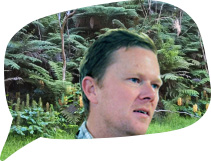Testimonials
In 2015, representatives from organisations across Northland formed a stakeholder group whose aims are to raise awareness of the impacts of Wild Ginger in Northland and find avenues of funding for biocontrol agents. Meet some of our representatives below and find out how Wild Ginger affects them. Contact us.

Don Mckenzie, Biosecurity Manager - Northland Regional Council
"I’ve witnessed the war on Wild Ginger for the last 30 years and although individuals and communities have won many battles I’m still seeing large areas infested with the weed.
I’ve seen it creep closer and closer to our finest kauri forests so that it now within Waipoua, Russell and many mid and far north forests - it is a forest invader as well as liking our roadsides and special places and it will invade under manuka - destroying habitats which can produce high quality honey. The plant forms a monoculture and dense overhead canopy so that native seedlings cannot germinate and its thick mat of rhizomes make the soil unsuitable for ground probing birds like kiwi.
We have been active in applying for biocontrol agents over the last 10 years and believe they can sometimes offer a smarter solution to controlling weeds. They can be very effective- they are not designed to eradicate the pest but reduce weed populations to low levels - the control of the weed mist flower throughout northland and ragwort has been successful only because of biological control agents brought in to specifically attack those weeds.
The mapping tool will give snap shot of the extent of Wild Ginger in our region- perhaps other regions will also contribute once they see the extent in Northland as it is my belief our region has several thousands of hectares and there is much more throughout New Zealand - it is well beyond our capability to hand weed or spray this weed- we need a smarter way of controlling this really harmful forest invader."

Lynley Hayes, Science team leader - Landcare Research.
Involved in the development of weed biocontrol programmes for 25 years. "Wild Ginger is one of the targets that we have been asked to explore the potential of biocontrol for because it is an ecosystem transforming weed with the potential to have even more serious unwanted harmful impacts than it currently does, unless we can develop some new or better control tools.
I have had 25 years of experience in the development of a wide range of biocontrol programmes for numerous weeds in New Zealand.
Biocontrols are a very effective tool. Data worldwide shows that for biocontrol programmes, 33% are so successful that no other control is required, 50% are moderately successful (providing useful control in some situations or in some years), and only 17% have no impact (usually because funding runs out to complete the work rather than a lack of good agents). New Zealand has already has considerable success with biocontrol against ragwort, mist flower, bridal creeper, heather, and partial success against nodding thistle and alligator weed. New Zealand also looks poised for widespread success in the near future against broom, Californian thistle, Wild Ginger and woolly nightshade.
I hope that biocontrol can provide an effective tool to more effectively manage Wild Ginger. The fact that Wild Ginger in its native range in India is an inconspicuous member of the native flora, and appears to be host to many natural enemies there which we can explore as potential biocontrol agents for NZ, bodes well for the prospects for successful biocontrol of Wild Ginger here.
I think many people will be surprised by the extent of Wild Ginger as shown currently on the map and will be shocked by likely future infestations if we cannot develop more effective control."

Spencer Jellyman, Parks Technical Officer - Whangarei District Council
"Within our parks, Wild Ginger is a constant threat to our native bush reserves, usually spreading from the reserve margins, slowing creeping further inwards. It is also one of the main problem weeds on our waterways and other unmaintained areas of land. We manage large areas of parks and reserves on behalf of the people (residents and visitors). Many of our pristine native forests are being invaded around the margins by Wild Ginger and from year to year, the problem gets bigger. As an organisation, we do not have the resources to control the Wild Ginger in all our sites. We do target a small number of high profile sites and attempt to eradicate Wild Ginger (and other weeds) from these sites by mechanical and chemical means, but this isn’t feasible on the larger scale. We are almost helpless watching our beautiful native forests being infiltrated by an aggressive, choking weed that is slowly undermining the biodiversity of our forests.
Recently I attended a presentation by Lynley Hayes, of Landcare Research, and learnt a lot about the implementation of biocontrol agents. This informative presentation opened my eyes to the potential that biocontrol can have in targeting out of control weeds. The presentation described a number of successful agent releases, where the weed is now under control and is in balance with a population of the biocontrol agent. It also described some releases that were not successful, demonstrating that the success of biocontrol is not a sure thing. However it was evident that through the use of science and thorough testing and procedures, that the likelihood of success is maximised. With many of the weed problems we face, biocontrol is really the only feasible control option left.
When biocontrol agents are released in Northland to control Wild Ginger, the ideal result would be a rapid decline in health of the Wild Ginger population at the release site. Following this would be a steady spread on the control agents out from the release site. If this happens, the challenge then will be to breed enough biocontrol agents to enable release sites throughout Northland, so the control of Wild Ginger on a district scale, can occur in a timely manner.
I think as people add their local Wild Ginger sites to the mapping tool, the map will become very telling, showing the distribution of Wild Ginger in Northland. I think people will be astounded by the scale of the Wild Ginger problem."


Clive Stone, Manager – Ngatiwai Resource Management Unit, Ngatiwai Kaitiaki
Dane Karapu, Assistant Manager – Ngatiwai Resource Management Unit, Ngatiwai Kaitiaki.
The Wild Ginger infestations that are located in the various parts of the Ngatiwai rohe have had a detrimental impact to our native forests and communities where they are suffocating and restricting the regrowth of our rongoa tipu (native plant life) and other native wildlife species like kiwi or tuatara which have negative effects on te mauri o te ngahere (the spiritual essence of the forests).
From an Iwi perspective, our major concern is with the state of the Wild Ginger growth over the past 30 years and how easily and quickly it spreads. Because most of it grows beneath the canopy of the surrounding bush, it has grown unnoticed at such a rapid rate that it has spread throughout some of the major forests within our rohe. We believe that if it is left unchecked, it will eventually take-over and destroy our native ngahere (forests) which in-turn will further threaten the survival of the other native wildlife species within these areas.
We hope that as a starting point, the biocontrol would set out and establish itself within the infested areas. We’d further hope that eventually the biocontrol would lead to the complete eradication of the Wild Ginger plants that are present within our forests which should in-turn lead to the assistance of the rejuvenation of our forests and all the indigenous flora and fauna within them.
We believe that by having the online mapping tool available the public will not only be able to see where Wild Ginger infestation areas are located and how bad they are, but also be able to add value by inputting some of their own information for the unknown areas from their knowledge base. Furthermore we hope that members of the public will fill out the online petition in support of our collaborated efforts towards the ongoing “Wild Ginger battle."

Tony Dwane, Environmental Planner - Hancock Forest Management
"Wild Ginger affects our ability to replant in those cases where Wild Ginger infestation is dense, as it increases costs. It also thrives under native species which makes it difficult to control in forest margins as the chemical used will kill all plants, including desirable native species so Wild Ginger ends up being left to spread along roadsides and stream riparian margins.
Wild Ginger can potentially invade native forests where it is difficult to eradicate and adds additional cost to forest.
I remember ragwort covering hillsides prior to the release of the ragwort flea beetle. It showed that biocontrols are less harmful than chemical use and more sustainable long term. I hope that a Wild Ginger biocontrol will successfully control the spread of Wild Ginger and eventually eradicate the plant.
The mapping tool will give a better understanding as to the extent and location of the Wild Ginger infestations within Northland."

Dan O’Halloran, Ranger Services Biodiversity - DOC Peiwhairangi/Bay of Islands Office
(20yrs experience in weed control work)
"Ongoing control operations by the Department around Whangaroa and community groups in Russell, Opua Forest and on Urupukapuka are heavily impacted by Wild Ginger infestations.
Wild Ginger is already a major problem in the Far North and has the potential to infest a great number of other sites.
Ive had experience working with the mist flower smut, which was extremely successful in practically eliminating a major forest invader that could never have been dealt using conventional methods.
Biocontrols are definitely an effective tool, as well as mistflower, ragwort has also been controlled using a biocontrol, and the species targeting Wild Ginger and tobacco weed are looking very promising. I hope that through importing a Wild Ginger biocontrol we will be able to stop the continual spread of this plant. This mapping tool should help people to realise the extent of the problem we are facing. "

Karen Lucich, Environmental & Administration Support - Summit Forests
I see Wild Ginger everywhere!
"Work – Wild Ginger quickly takes over native wetlands and riparian areas. It spreads through the understory of mature pine forest. Wild Ginger is very difficult to move through. It needs to be sprayed out prior to re - planting or it will smother the young trees.
Community – Wild Ginger is choking our streams and rivers. It is rapidly spreading along stream banks, road verges and through scrub land. It out competes native vegetation and is changing ecosystems. Wild Ginger is resilient – needs potent spray to kill and it produces a massive amounts of seed. My concern is that we have lost the battle with our current tactics. Wild Ginger is a very aggressive coloniser. It is already so widespread and in some very isolated and difficult terrain. It has the potential to prevent regeneration of our native forests and cause wide scale ecosystem collapse. We could lose a lot of biodiversity.
I think well researched biocontrols can be very successful at controlling their target.
I have seen the great job the ragwort flea beetle is doing. Recently I’ve seen the woolly nightshade lacebug working away and hope it starts to make a widespread impact soon. I hope that a Wild Ginger biocontrol will reverse the trend. Idealistically I’d like Wild Ginger eradicated, realistically if the biocontrols could slow the spread and eventually reduce Wild Ginger infestation to the occasional relic reminder.
Many people do not recognise Wild Ginger or the threat it poses to our environment / economy. A picture tells 1000 words - the mapping tool will get people thinking, talking and supporting this campaign by highlighting the current problem and projection of the future spread if left to current control methods. "

Murray Braithwaite, Operations Manager - Summit Forests New Zealand Ltd, Kaitaia
(46 years Forest Industry experience)
Wild Ginger has become a lot more rampant over the last few years popping up and taking over in areas where it hadn’t been noticed before. It has completely covered the forest floor in places and is taking over our stream riparian and road edges throughout the District.
If this plant isn’t controlled it will eventually invade our native forests and due to its high shade tolerance will end up covering the forest floor. This will prevent young seedlings from growing and as the old trees die it could collapse the forest ecosystem.
I have assisted with the release of the ragwort beetle and have lately witnessed the effects on the woolly nightshade weed - biocontrols have been released on aggressive plants which could not be managed by other means and to date have been highly successful.
I would like to see the Wild Ginger controlled like the ragwort is. To see the biocontrol silently doing its job wherever it is growing, keeping it under control so that it doesn’t need spraying and it is kept out of our prime native reserves.
If we know what we are dealing with then better decisions are made on how to deal with the problem. We don’t know all the places Wild Ginger is located and how rampant it is in those locations. We need the community support for this and I am sure if they become aware of the threat this weed poses to our native forests they will be willing to help.

Mike Collins, Parks and Reserves Officer - Kaipara District Council
"Pockets of Wild Ginger are appearing and growing in our reserves and public spaces at an increasingly worrying speed. This is affecting the public’s enjoyment of their space and will damage our native environments. While the Wild Ginger infestation is not as prolific in Kaipara as other districts it is a concerning that at a regional level so much damage is being done. We have some unique ecosystems in Northland which if lost will be lost forever.
I believe that biocontrols are an effective tool and, thanks to some very robust science and systems, a very safe control. Hopefully the introduction of Wild Ginger biocontrols will help in its control and make the use of more conventional methods much more effective.
The mapping tool will be a great help, not only to raise public awareness of the problem but also help reveal the true scope and spread of the problem. It will also help show the public that this is an issue that extends further than their “backyard”. In addition an increase in public awareness and support may provide the added pressure on Central Government to act."

Zane Wright, Technical Officer – Far North District Council
"Wild Ginger impacts on our work as at times we receive requests from members of the public in regards to the removal of Wild Ginger situated on council reserves & roadsides.
Wild Ginger has spread rapidly in many areas of the North and if left untouched it will only get worse.
The mapping tool will be helpful as the majority of the public are unaware of how big of a problem Wild Ginger is, and how quickly it is spreading."
All media enquiries and for further information please contact Ashlee Lawrence, Biosecurity Officer, at 0800 002 004 or ashleel@nrc.govt.nz




















